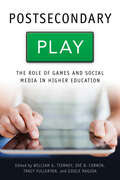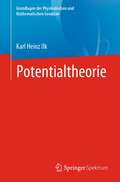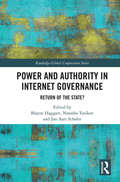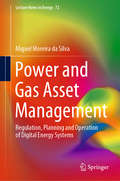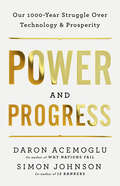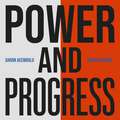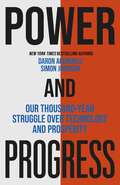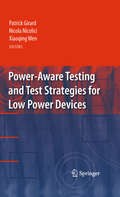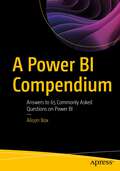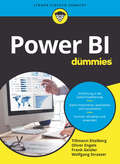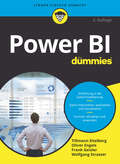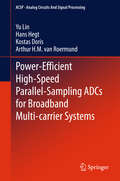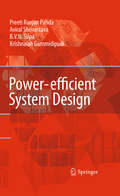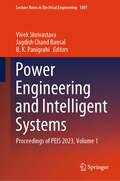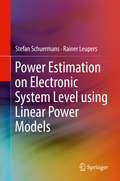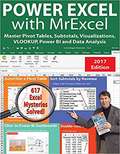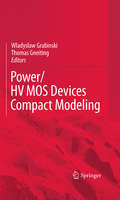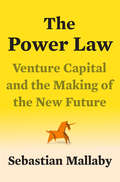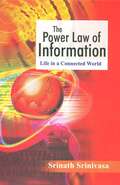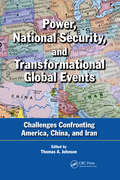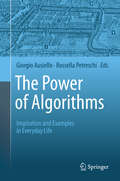- Table View
- List View
Postsecondary Play: The Role of Games and Social Media in Higher Education (Tech.edu: A Hopkins Series on Education and Technology)
by William G. Tierney, Zoë B. Corwin, Tracy Fullerton and Gisele RagusaGames and social media can improve college access, attract and support students, and boost rates of completion.The college application process—which entails multiple forms, essays, test scores, and deadlines—can be intimidating. For students without substantial school and family support, the complexity of this process can become a barrier to access. William G. Tierney, Tracy Fullerton, and their teams at the University of Southern California approach this challenge innovatively. Using the tools of online games and social media, they have developed ways to make applying for college much less intimidating.While the vast majority of college students use social media and gaming in their everyday lives, colleges and universities have been slow to recognize and harness the power of either. Postsecondary Play explores the significance of games and social media in higher education, and particularly how they can be used to attract, retain, educate, and socialize students.Tierney, a past president of the American Educational Research Association, has gathered some of the best research on the emerging role of games and social media in the classroom and how these tools can boost student confidence and increase college access. Scholars writing from a wide variety of disciplines—college access, social media, game studies, and learning sciences—provide concrete examples to illustrate the new and complex ways in which students learn in response to social media and games. Tierney and the contributors find that, although games can be powerful tools for encouraging underserved students, quality game design and mastering the concept of play—the ability to develop skills while engaging in the game—are essential in the effective use of serious games in teaching and learning.Summarizing a decade of research in game design and learning, Postsecondary Play will appeal to higher education scholars and students of learning, online gaming, education, and the media.
Potentialtheorie (Grundlagen der Physikalischen und Mathematischen Geodäsie)
by Karl Heinz IlkDieses Lehrbuch aus der Reihe „Grundlagen der Physikalischen und Mathematischen Geodäsie“ behandelt die für die Physikalische Geodäsie wichtigen Elemente der Potentialtheorie. Es führt in die feldtheoretischen Aspekte des Gravitationsfeldes ein und erklärt die wichtigen Grundlagen für die Lösung der geodätischen Randwertaufgaben. Der Autor erläutert ausführlich die Darstellung der verschiedenen Gravitationsfeldfunktionale durch Kugelfunktionen sowie die Transformationseigenschaften bei Translation und Drehung des zugrundeliegenden Koordinatensystems. Verschiedene Aspekte der Kugelfunktionen werden außerdem vertieft betrachtet, insbesondere die Darstellungen von Gravitationsfeldwechselwirkungen ausgedehnter Massenanordnungen, also Drehmomente, Gravitationstensor, Gezeitenpotential und vieles mehr.
Potion of the Turtle Master: An Unofficial Minecrafters Novel (Aquatic Adventures in the Overworld #4)
by Maggie MarksWhen sea turtles are trapped in an underwater cave, Mason and Luna are determined to get them out. Asher wants to use TNT to blast a tunnel, but Luna insists that mining slowly is safer. Then the guardians show up, claiming the cave as their own. Now the turtles aren’t the only ones in danger! Can Mason find a way to save himself from the deadly sea creatures, too? Find out more in this incredible fourth book of Aquatic Adventures in the Overworld: Potion of the Turtle Master! <p> Brothers Mason and Asher are learning how to cope with life outside the Overworld after a terrifying shipwreck that left them stranded underwater. Teamed up with their new friend Luna, this unlikely trio must make the choice of staying in the world they know best and risk death, or voyaging into an unknown world where anything could happen. In each story of the series for Minecrafters, follow their journey as Mason, Asher, and Luna face incredible obstacles and discover strength they never knew they had in Aquatic Adventures in the Overworld.
Power and Authority in Internet Governance: Return of the State? (Routledge Global Cooperation Series)
by Blayne Haggart Natasha Tusikov Jan Aart ScholtePower and Authority in Internet Governance investigates the hotly contested role of the state in today's digital society. The book asks: Is the state "back" in internet regulation? If so, what forms are state involvement taking, and with what consequences for the future? The volume includes case studies from across the world and addresses a wide range of issues regarding internet infrastructure, data and content. The book pushes the debate beyond a simplistic dichotomy between liberalism and authoritarianism in order to consider also greater state involvement based on values of democracy and human rights. Seeing internet governance as a complex arena where power is contested among diverse non-state and state actors across local, national, regional and global scales, the book offers a critical and nuanced discussion of how the internet is governed – and how it should be governed. Power and Authority in Internet Governance provides an important resource for researchers across international relations, global governance, science and technology studies and law as well as policymakers and analysts concerned with regulating the global internet.
Power and Gas Asset Management: Regulation, Planning and Operation of Digital Energy Systems (Lecture Notes in Energy #72)
by Miguel Moreira da SilvaThis book offers meaningful insights into an impending challenge for the energy industry, namely the increasing role of asset management amongst the utilities’ core operations. In the aftermath of energy digitalization, power and gas companies will be able to seize asset productivity—through risk-based operation and maintenance—and better balance capital and operational expenditures. By addressing the asset management of both power and gas infrastructures, and by adopting a comprehensive approach—including regulation and business models, as well as a solid technology background—this book offers a unique perspective on the energy utilities’ transformation journey and the road to optimal decision-making for both asset portfolio expansion and replacement. The asset management end-to-end mission requires appropriate internal governance—depending on the business framework—and the development of decision aid models (for asset replacement and maintenance), supported on probabilistic risk and reliability indexes. This book advocates systematically digitalizing the power and gas assets, addressing both data governance and infrastructure, alongside real-time equipment condition monitoring. It also provides a meaningful methodology for designing data-centric asset management and predictive operation and maintenance, using artificial intelligence and engineering-based approaches. As such, it provides valuable strategy, methods and models—illustrated by case studies and proofs of concept—for a wide range of stakeholders, including utilities and industry professionals, regulators, policy-makers, researchers and students.
Power and Progress: Our Thousand-Year Struggle Over Technology and Prosperity
by Daron Acemoglu Simon JohnsonThe bestselling co-author of Why Nations Fail and the bestselling co-author of 13 Bankers deliver a bold reinterpretation of economics and history that will fundamentally change how you see the world A thousand years of history and contemporary evidence make one thing clear: progress depends on the choices we make about technology. New ways of organizing production and communication can either serve the narrow interests of an elite or become the foundation for widespread prosperity. The wealth generated by technological improvements in agriculture during the European Middle Ages was captured by the nobility and used to build grand cathedrals, while peasants remained on the edge of starvation. The first hundred years of industrialization in England delivered stagnant incomes for working people. And throughout the world today, digital technologies and artificial intelligence undermine jobs and democracy through excessive automation, massive data collection, and intrusive surveillance. It doesn&’t have to be this way. Power and Progress demonstrates the path of technology was once—and may again—be brought under control. Cutting-edge technological advances can become empowering and democratizing tools, but not if all major decisions remain in the hands of a few hubristic tech leaders. With their bold reinterpretation of economics and history, Daron Acemoglu and Simon Johnson fundamentally change how we see the world, providing the vision needed to redirect innovation so it again benefits most people.
Power and Progress: Our Thousand-Year Struggle Over Technology and Prosperity
by Simon Johnson Daron AcemogluTwo bestselling authors deliver a bold new interpretation of why technology has all too often benefited elites - and how we must reshape the path of innovation to create true shared prosperity.A thousand years of history and contemporary evidence make one thing clear. Progress is not automatic but depends on the choices we make about technology. New ways of organizing production and communication can either serve the narrow interests of an elite or become the foundation for widespread prosperity.Much of the wealth generated by agricultural advances during the European Middle Ages was captured by the Church and used to build grand cathedrals while the peasants starved. The first hundred years of industrialization in England delivered stagnant incomes for workers, while making a few people very rich. And throughout the world today, digital technologies and artificial intelligence increase inequality and undermine democracy through excessive automation, massive data collection, and intrusive surveillance.It doesn't have to be this way. Power and Progress demonstrates that the path of technology was once - and can again be - brought under control. The tremendous computing advances of the last half century can become empowering and democratizing tools, but not if all major decisions remain in the hands of a few hubristic tech leaders striving to build a society that elevates their own power and prestige.With their breakthrough economic theory and manifesto for a better society, Acemoglu and Johnson provide the understanding and the vision to reshape how we innovate and who really gains from technological advances so we can create real prosperity for all.(P) 2023 Hachette Audio
Power and Progress: Our Thousand-Year Struggle Over Technology and Prosperity
by Simon Johnson Daron Acemoglu'The blueprint we need for the challenges ahead' Shoshana Zuboff'If you are not already an addict of Daron Acemoglu and Simon Johnson's previous books, Power and Progress is guaranteed to make you one' Jared Diamond'A breathtaking tour of the history and future of technology' Abhijit Banerjee and Esther DufloA bold new interpretation of why technology has all too often benefited elites - and how we must reshape the path of innovation to create true shared prosperity.A thousand years of history and contemporary evidence make one thing clear. Progress is not automatic but depends on the choices we make about technology. New ways of organizing production and communication can either serve the narrow interests of an elite or become the foundation for widespread prosperity.Much of the wealth generated by agricultural advances during the European Middle Ages was captured by the Church and used to build grand cathedrals while the peasants starved. The first hundred years of industrialization in England delivered stagnant incomes for workers, while making a few people very rich. And throughout the world today, digital technologies and artificial intelligence increase inequality and undermine democracy through excessive automation, massive data collection, and intrusive surveillance.It doesn't have to be this way. Power and Progress demonstrates that the path of technology was once - and can again be - brought under control. The tremendous computing advances of the last half century can become empowering and democratizing tools, but not if all major decisions remain in the hands of a few hubristic tech leaders striving to build a society that elevates their own power and prestige.With their breakthrough economic theory and manifesto for a better society, Acemoglu and Johnson provide the understanding and the vision to reshape how we innovate and who really gains from technological advances so we can create real prosperity for all.
Power-Aware Testing and Test Strategies for Low Power Devices
by Xiaoqing Wen Nicola Nicolici Patrick GirardManaging the power consumption of circuits and systems is now considered one of the most important challenges for the semiconductor industry. Elaborate power management strategies, such as dynamic voltage scaling, clock gating or power gating techniques, are used today to control the power dissipation during functional operation. The usage of these strategies has various implications on manufacturing test, and power-aware test is therefore increasingly becoming a major consideration during design-for-test and test preparation for low power devices. This book explores existing solutions for power-aware test and design-for-test of conventional circuits and systems, and surveys test strategies and EDA solutions for testing low power devices.
A Power BI Compendium: Answers to 65 Commonly Asked Questions on Power BI
by Alison BoxAre you a reasonably competent Power BI user but still struggling to generate reports that truly tell the story of your data? Or do you simply want to extend your knowledge of Power BI by exploring more complex areas of visualizations, data modelling, DAX, and Power Query? If so, this book is for you. This book serves as a comprehensive resource for users to implement more challenging visuals, build better data models, use DAX with more confidence, and execute more complex queries so they can find and share important insights into their data. The contents of the chapters are in a question-and-answer format that explore everyday data analysis scenarios in Power BI. These questions have been generated from the author’s own client base and from commonly sought-for information from the Power BI community. They cover a wide and diverse range of topics that many Power BI users often struggle to get to grips with or don’t fully understand. Examples of such questions are: How can I generate dynamic titles for visuals?How can I control subtotals in a Matrix visual?Why do I need a date dimension?How can I show the previous N month’s sales in a column chart?Why do I need a Star Schema?Why aren't my totals correct?How can I bin measures into numeric ranges?Can I import a Word document?Can I dynamically append data from different source files? Solutions to these questions and many more are presented in non-technical and easy-to-follow explanations negating the requirement to perform tiresome and fruitless “google” searches. There are also companion Power BI Desktop files that set out the answers to each question so you can follow along with the examples given in the book.. After working through this book, you will have extended your knowledge of Power BI to an expert level, alleviating your existing frustrations and so enabling you to design Power BI reports where you are no longer limited by your lack of knowledge or experience. Who is This Book For: Power BI users who can build reports and now want to extend their knowledge of Power BI.
Power BI für Dummies (Für Dummies)
by Frank Geisler Tillmann Eitelberg Oliver Engels Wolfgang StrasserSie möchten, was Datenanalyse angeht, noch eine Schippe drauflegen? Dann steigen Sie auf die Microsoft Self Service BI Lösung "Power BI" um. Dieses Buch zeigt Ihnen die unzähligen Möglichkeiten, die Power BI bietet, um Ihre Daten aufzubereiten und ansprechend zu präsentieren. Zunächst lernen Sie die notwendigen Grundlagen kennen, um danach tief in die Welt der Datenauswertungen, DAX-Formeln, Power BI Data Flows, Custom Visuals, Dashboards und vielem mehr abzutauchen. Sie benötigen dazu keine großen IT-Kenntnisse - Erfahrung mit Excel reicht vollkommen aus. Mithilfe von vielen Praxisbeispielen lernen Sie schnell, sowohl mit dem Power BI Desktop Client als auch mit dem Power BI Cloud Service zu arbeiten.
Power BI für Dummies (Für Dummies)
by Frank Geisler Tillmann Eitelberg Oliver Engels Wolfgang StrasserSie möchten, was Datenanalyse angeht, noch eine Schippe drauflegen? Dann steigen Sie auf die Microsoft-Self-Service-BI-Lösung "Power BI" um. Dieses Buch zeigt Ihnen die unzähligen Möglichkeiten, die Power BI bietet, um Ihre Daten aufzubereiten und ansprechend zu präsentieren. Zunächst lernen Sie die notwendigen Grundlagen kennen, um danach tief in die Welt der Datenauswertungen, DAX-Formeln, Power BI Data Flows, Custom Visuals, Dashboards und vielem mehr abzutauchen. Sie benötigen dazu keine großen IT-Kenntnisse - Erfahrung mit Excel reicht vollkommen aus. Mithilfe von vielen Praxisbeispielen lernen Sie schnell, sowohl mit dem Power BI Desktop Client als auch mit dem Power BI Cloud Service zu arbeiten.
Power Composition for Photography
by Tom GallovichIn this book, Tom Gallovich shows readers how to use their camera's exposure controls (aperture, shutter speed, ISO) to establish the focal point of the image and create the overall mood of the shot and choose a particular lens or focal-length setting to massage the way elements in the original scene will appear within the frame. Next, he presents chapters on using shape, color, lines, and arrangement to strengthen the intended visual message. Readers will learn how to best place their primary subject (and in some cases secondary subject) for maximum impact and will discover artistic strategies that reinforce that decision through careful use of color, tone, highlight and shadow, leading lines, curved shapes, and relative size-qualities that will contribute to the overall mood in the image. Copious illustrations emphasize the impact that putting these concepts into play will have on your images-and these are often coupled with images that show how ineffective images are when those important compositional needs are not attended to.
Power-Efficient High-Speed Parallel-Sampling ADCs for Broadband Multi-carrier Systems
by Yu Lin Hans Hegt Kostas Doris Arthur H. M. RoermundThis book addresses the challenges of designing high performance analog-to-digital converters (ADCs) based on the "smart data converters" concept, which implies context awareness, on-chip intelligence and adaptation. Readers will learn to exploit various information either a-priori or a-posteriori (obtained from devices, signals, applications or the ambient situations, etc. ) for circuit and architecture optimization during the design phase or adaptation during operation, to enhance data converters performance, flexibility, robustness and power-efficiency. The authors focus on exploiting the a-priori knowledge of the system/application to develop enhancement techniques for ADCs, with particular emphasis on improving the power efficiency of high-speed and high-resolution ADCs for broadband multi-carrier systems.
Power-efficient System Design
by Preeti Ranjan Panda Krishnaiah Gummidipudi B. V. Silpa Aviral ShrivastavaThis book addresses power optimization in modern electronic and computer systems. Several forces aligned in the past decade to drive contemporary computing in the direction of low power and energy-awareness: the mobile revolution took the world by storm; power budgets forced mainstream processor designers to abandon the quest for higher clock frequency; and large data centers with overwhelming power costs began to play vital roles in our daily lives. Power optimization was elevated to a first class design concern, forcing everyone from the process engineer, circuit designer, processor architect, software developer, system builder, and even data center maintainer to make conscious efforts to reduce power consumption using myriad techniques and tools. This book explores power optimization opportunities and their exploitation at various levels of abstraction. Fundamental power optimizations are covered at each level of abstraction, concluding in a case study illustrating the application of the major techniques to a graphics processor. This book covers a comprehensive range of disparate power optimizations and is designed to be accessible to students, researchers, and practitioners alike.
Power Engineering and Intelligent Systems: Proceedings of PEIS 2023, Volume 1 (Lecture Notes in Electrical Engineering #1097)
by Vivek Shrivastava Jagdish Chand Bansal B. K. PanigrahiThe book presents a collection of the high-quality research articles in the field of power engineering, grid integration, energy management, soft computing, artificial intelligence, signal and image processing, data science techniques, and their real-world applications. The papers are presented at International Conference on Power Engineering and Intelligent Systems (PEIS 2023), held during June 24–25, 2023, at National Institute of Technology Delhi, India.
Power Engineering and Intelligent Systems: Proceedings of PEIS 2023, Volume 2 (Lecture Notes in Electrical Engineering #1098)
by Vivek Shrivastava Jagdish Chand Bansal Bijaya Ketan PanigrahiThe book presents a collection of the high-quality research articles in the field of power engineering, grid integration, energy management, soft computing, artificial intelligence, signal and image processing, data science techniques, and their real-world applications. The papers are presented at International Conference on Power Engineering and Intelligent Systems (PEIS 2023), held during June 24 – –25, 2023, at National Institute of Technology, Delhi, India.
Power Estimation on Electronic System Level using Linear Power Models
by Stefan Schuermans Rainer LeupersThis book describes a flexible and largely automated methodology for adding the estimation of power consumption to high level simulations at the electronic system level (ESL). This method enables the inclusion of power consumption considerations from the very start of a design. This ability can help designers of electronic systems to create devices with low power consumption. The authors also demonstrate the implementation of the method, using the popular ESL language “SystemC”. This implementation enables most existing SystemC ESL simulations for power estimation with very little manual work. Extensive case-studies of a Network on Chip communication architecture and a dual-core application processor “ARM Cortex-A9” showcase the applicability and accuracy of the method to different types of electronic devices. The evaluation compares various trade-offs regarding amount of manual work, types of ESL models, achieved estimation accuracy and impact on the simulation speed.Describes a flexible and largely automated ESL power estimation method;Shows implementation of power estimation methodology in SystemC;Uses two extensive case studies to demonstrate method introduced.
Power Excel 2016 with MrExcel
by Bill JelenUpdating the previous edition's tips to include features in Excel 2016, this new edition of MrExcel's popular software guide even incorporates suggestions sent in by readers. Each featured topic has a problem statement and description, followed by a broad strategy for solving the problem. MrExcel then walks readers through the specific steps to solve the issue. Alternate strategies are also provided, along with common scenarios that trip users up, leaving readers with not only answers to their specific dilemmas but also new and quicker ways to use formulas and spreadsheets.
POWER/HVMOS Devices Compact Modeling
by Thomas Gneiting Wladyslaw GrabinskiSemiconductor power electronics plays a dominant role due its increased efficiency and high reliability in various domains including the medium and high electrical drives, automotive and aircraft applications, electrical power conversion, etc. Power/HVMOS Devices Compact Modeling will cover very extensive range of topics related to the development and characterization power/high voltage (HV) semiconductor technologies as well as modeling and simulations of the power/HV devices and smart power integrated circuits (ICs). Emphasis is placed on the practical applications of the advanced semiconductor technologies and the device level compact/spice modeling. This book is intended to provide reference information by selected, leading authorities in their domain of expertise. They are representing both academia and industry. All of them have been chosen because of their intimate knowledge of their subjects as well as their ability to present them in an easily understandable manner.
The Power Law: Venture Capital and the Making of the New Future
by Sebastian Mallaby"A rare and unsettling look inside a subculture of unparalleled influence.&” —Jane Mayer"A classic...A book of exceptional reporting, analysis and storytelling.&” —Charles DuhiggFrom the New York Times bestselling author of More Money Than God comes the astonishingly frank and intimate story of Silicon Valley&’s dominant venture-capital firms—and how their strategies and fates have shaped the path of innovation and the global economyInnovations rarely come from &“experts.&” Elon Musk was not an &“electric car person&” before he started Tesla. When it comes to improbable innovations, a legendary tech VC told Sebastian Mallaby, the future cannot be predicted, it can only be discovered. It is the nature of the venture-capital game that most attempts at discovery fail, but a very few succeed at such a scale that they more than make up for everything else. That extreme ratio of success and failure is the power law that drives the VC business, all of Silicon Valley, the wider tech sector, and, by extension, the world. In The Power Law, Sebastian Mallaby has parlayed unprecedented access to the most celebrated venture capitalists of all time—the key figures at Sequoia, Kleiner Perkins, Accel, Benchmark, and Andreessen Horowitz, as well as Chinese partnerships such as Qiming and Capital Today—into a riveting blend of storytelling and analysis that unfurls the history of tech incubation, in the Valley and ultimately worldwide. We learn the unvarnished truth, often for the first time, about some of the most iconic triumphs and infamous disasters in Valley history, from the comedy of errors at the birth of Apple to the avalanche of venture money that fostered hubris at WeWork and Uber. VCs&’ relentless search for grand slams brews an obsession with the ideal of the lone entrepreneur-genius, and companies seen as potential &“unicorns&” are given intoxicating amounts of power, with sometimes disastrous results. On a more systemic level, the need to make outsized bets on unproven talent reinforces bias, with women and minorities still represented at woefully low levels. This does not just have social justice implications: as Mallaby relates, China&’s homegrown VC sector, having learned at the Valley&’s feet, is exploding and now has more women VC luminaries than America has ever had. Still, Silicon Valley VC remains the top incubator of business innovation anywhere—it is not where ideas come from so much as where they go to become the products and companies that create the future. By taking us so deeply into the VCs&’ game, The Power Law helps us think about our own future through their eyes.
The Power Law of Information: Life in A Connected World (Response Books)
by Srinath SrinivasaWe live in an era of unparalleled access to information and communication technologies. The Internet and other information tools like the television are becoming ever more central to our lives—we chat, blog, e-mail and e-shop, leaving behind our footprints in this version of public space. In addition, we are constantly bombarded with different kinds of information that seek to mould our thinking in subtle ways. The reader of this book will discover that social information networks possess qualities that are counter-intuitive. Social information networks form what are called frictionless, nonlinear systems. The behaviour of such systems can be extremely complex, making it hard to predict, let alone control. Despite this, there are some common features displayed by such systems, especially the ‘power law’ distribution. A power law distribution of societal influence, for example, would depict a society where a small percentage of society would wield enormous clout, while the larger part would have very little or no influence. Such a society would be highly polarized, with no room for the middle ground. The book investigates properties of frictionless, non-linear systems and the unconventional thought processes needed to comprehend them. It also shows how information affects us in a variety of ways: be it human rationality, the spread of ideas in society, or global monetary systems. Drawing upon current research, the author offers directions on how to model the new world taking shape and possibly to also steer it in the right direction.
Power, National Security, and Transformational Global Events: Challenges Confronting America, China, and Iran
by Thomas A. JohnsonAs the United States struggled to survive the recent recession, China quietly acquired a vast amount of U.S. Treasury bills and bonds. With China now holding so much of America‘s debt, currency valuation issues have already caused tensions between the two superpowers. Couple this with Iran‘s efforts to develop into a nuclear power in an area that l
The Power of Algorithms
by Giorgio Ausiello Rossella PetreschiTo examine, analyze, and manipulate a problem to the point of designing an algorithm for solving it is an exercise of fundamental value in many fields. With so many everyday activities governed by algorithmic principles, the power, precision, reliability and speed of execution demanded by users have transformed the design and construction of algorithms from a creative, artisanal activity into a full-fledged science in its own right. This book is aimed at all those who exploit the results of this new science, as designers and as consumers. The first chapter is an overview of the related history, demonstrating the long development of ideas such as recursion and more recent formalizations such as computability. The second chapter shows how the design of algorithms requires appropriate techniques and sophisticated organization of data. In the subsequent chapters the contributing authors present examples from diverse areas - such as routing and networking problems, Web search, information security, auctions and games, complexity and randomness, and the life sciences - that show how algorithmic thinking offers practical solutions and also deepens domain knowledge. The contributing authors are top-class researchers with considerable academic and industrial experience; they are also excellent educators and communicators and they draw on this experience with enthusiasm and humor. This book is an excellent introduction to an intriguing domain and it will be enjoyed by undergraduate and postgraduate students in computer science, engineering, and mathematics, and more broadly by all those engaged with algorithmic thinking.
The Power of Artificial Intelligence for the Next-Generation Oil and Gas Industry: Envisaging AI-inspired Intelligent Energy Systems and Environments (IEEE Press Series on Power and Energy Systems)
by Pethuru Raj Chelliah Venkatraman Jayasankar Mats Agerstam B. Sundaravadivazhagan Robin CyriacThe Power of Artificial Intelligence for the Next-Generation Oil and Gas Industry Comprehensive resource describing how operations, outputs, and offerings of the oil and gas industry can improve via advancements in AI The Power of Artificial Intelligence for the Next-Generation Oil and Gas Industry describes the proven and promising digital technologies and tools available to empower the oil and gas industry to be future-ready. It shows how the widely reported limitations of the oil and gas industry are being nullified through the application of breakthrough digital technologies and how the convergence of digital technologies helps create new possibilities and opportunities to take this industry to its next level. The text demonstrates how scores of proven digital technologies, especially in AI, are useful in elegantly fulfilling complicated requirements such as process optimization, automation and orchestration, real-time data analytics, productivity improvement, employee safety, predictive maintenance, yield prediction, and accurate asset management for the oil and gas industry. The text differentiates and delivers sophisticated use cases for the various stakeholders, providing easy-to-understand information to accurately utilize proven technologies towards achieving real and sustainable industry transformation. The Power of Artificial Intelligence for the Next-Generation Oil and Gas Industry includes information on: How various machine and deep learning (ML/DL) algorithms, the prime modules of AI, empower AI systems to deliver on their promises and potential Key use cases of computer vision (CV) and natural language processing (NLP) as they relate to the oil and gas industry Smart leverage of AI, the Industrial Internet of Things (IIoT), cyber physical systems, and 5G communication Event-driven architecture (EDA), microservices architecture (MSA), blockchain for data and device security, and digital twins Clearly expounding how the power of AI and other allied technologies can be meticulously leveraged by the oil and gas industry, The Power of Artificial Intelligence for the Next-Generation Oil and Gas Industry is an essential resource for students, scholars, IT professionals, and business leaders in many different intersecting fields.
